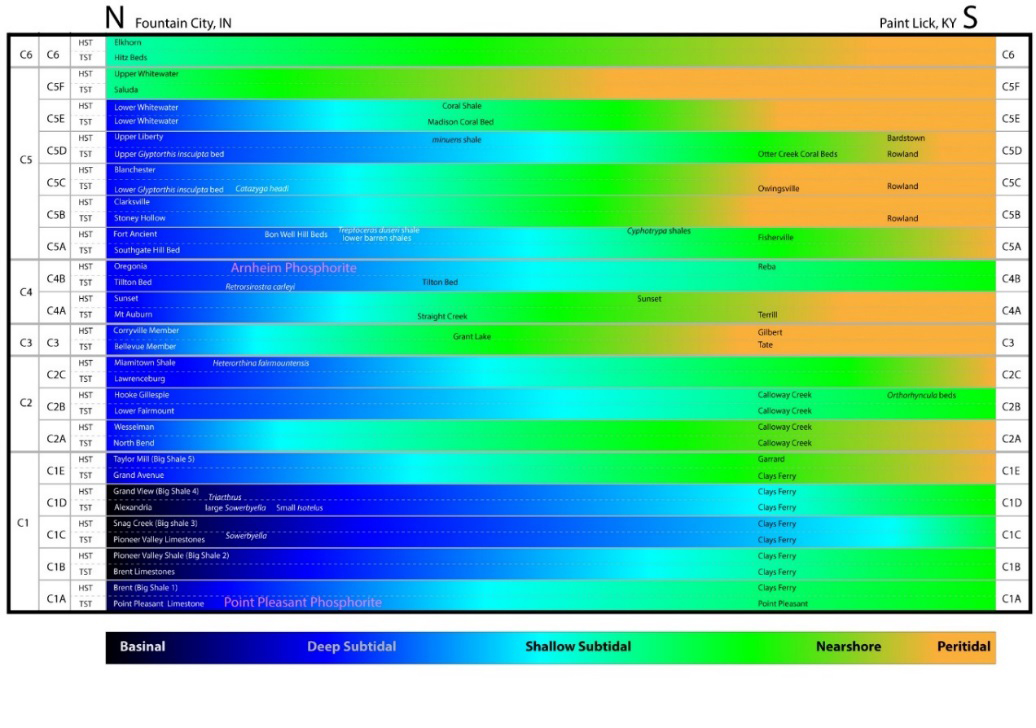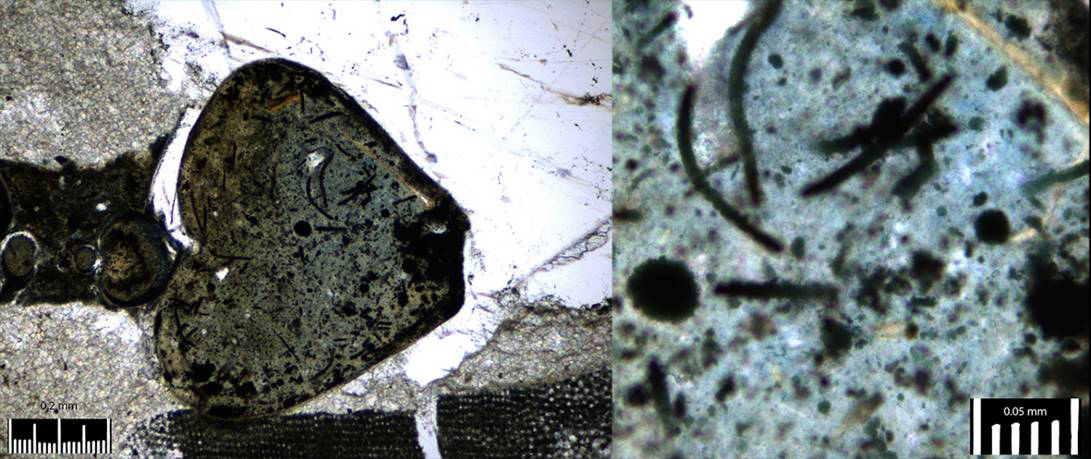Reports: UR855225-UR8: Do Cincinnatian (Ordovician) Phosphorites Result from Instrinsic Organic Burial Processes or Extrinsic Conditions?
Benjamin F. Dattilo, PhD, Indiana University-Purdue University, Fort Wayne
Impacts on StudentsM
Two students were supported, each for three months. As a result of this support, one student was able to graduate. Another student was able to more easily integrate back into academic life after returning from a military tour of duty.
Accomplishments and outcomes
Sampling the stratigraphic framework
One of our central aims was to document the occurrence of phosphate throughout the Cincinnatian and to place it in a stratigraphic context in order to In the course of this year, our sample collecting was done in close collaboration with Carl Brett and graduate students from the University of Cincinnati. The result was to finish outlining the 4th-order sequence stratigraphic framework for Ordovician rocks in the Cincinnati Region. This new stratigraphic framework helps us not only in placing samples in the correct stratigraphic context, but the complex facies changes show how the temporal signal might be distorted by conflation with depositional environment signal.
Fig 1. Simplified decameter-scale (4th order) sequence stratigraphy of the Cincinnatian, time/environment diagram showing depth facies only, with 4th order unconformities (in the peritidal section to the south) omitted for clarity. Facies for each 4th order sequence are generalized from proximal (south) to distal (north) as peritidal (orange), nearshore (green), shallow subtidal (aqua), deep subtidal (blue) and basinal (black). This is a coarse representation of the high-resolution scaffolding that has been established through decades of stratigraphic work at the University of Cincinnati. Note the overall progradation for the Cincinnatian 2nd order sequence and the higher frequency facies shifts for smaller scale sequences. Regional outcrops of peritidal facies are unavailable for most of the C1, while outcrops of deep subtidal facies are unavailable for the C5F and C6
To date we have nearly completed sampling and processing enough to get a good picture of how phosphate varies not only temporally but also environmentally from deeper subtidal to peritidal depositional settings, and between transgressive and regressive phases.
Fig 2. Cross section of the study area showing outcrop and core sections projected onto a single transect (shown on the figure as a yellow line) and superimposed on generalized 4th-order facies. All outcrops have been stratigraphically assessed and 4th-order sequence boundaries identified. White designates outcrops that have not yet been sampled for this study, yellow designates outcrops with pilot studies or that have been sampled, and red indicates reference core samples stored at the Indiana (I), Kentucky (K). Darker shades of all three colors are the eastern outcrop belt, medium shades are the central outcrop belt and unshaded colors are the western outcrop belt. Dotted outline rectangles are sample sets and studies of densely spaced outcrops where individual outcrops cannot all be represented.
Pilot studies in Geochemistry
In a joint undergraduate research project with Bill Gillhooly at Indiana University Purdue University Indianapolis, we began detailed geochemical analysis of 10 meters of salvaged geotechnical core through part of the study interval in northern Kentucky. These analyses include high resolution nitrogen isotopes and elemental abundance data to estimate oxidation state of the water column and sediment for both mudstone and limestone.
Echinoderm diagenesis
Our initial analysis of thin sections from different phosphate rich horizons suggests a multi-stage process of phosphate precipitation and calcite dissolution as shown in echinoderm grains. We observe the grains in a single bed to be preserved at different stages of the process, suggesting that grains enter the shell accumulation over a long period of active sea-floor diagenesis.
Fig 3. Thin section photomicrograph of phosphatized echinoderm stereom showing phosphate that partially filled the stereom galleries and pyrite which replaced some of the stereom calcite trabeculae.
Bacterial fossils encased in phosphate
One of our exciting finds was the discovery of “tubes” filaments about 10 microns across and filled more or less with strings of euhedral and framboidal pyrite. The consistent width of these tubes suggest strongly that they are fossil bacterial, and, like echinoderm ossicles, they appear to be found in various stages of preservation.
Fig 4. Thin section photomicrographs, low magnification (left) and high magnification of probable fossil bacteria preserved as pyrite (black in transmitted light)
PI career impacts
Work on this research has resulted in the preparation and submission of NSF grant proposal: “Collaborative Research: Phosphatic sediments as products of carbonate sediment maturation, a new hypothesis of phosphorite deposition in an Ordovician epeiric sea”.















